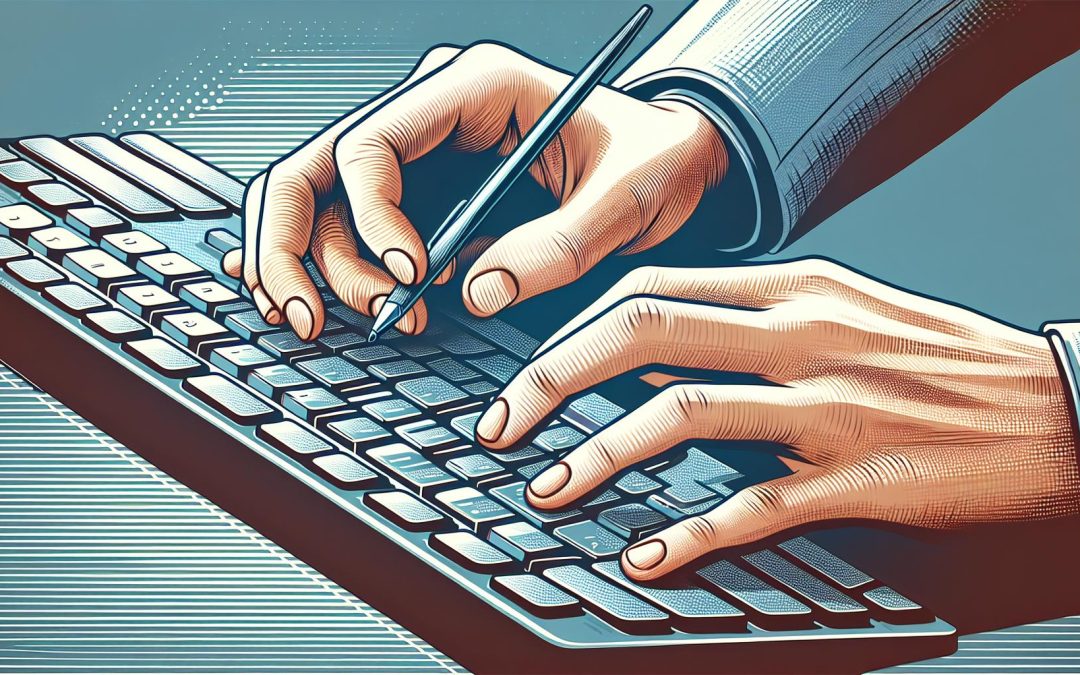Stepping into the world of typing can feel like embarking on a thrilling journey. For beginners, the keyboard is a vast landscape, waiting to be explored. But before setting out, it's crucial to get those fingers in shape! Just like athletes warm up before a game, typists need their own set of exercises to keep their fingers agile and ready for action.
That's where keyboard finger exercises come into play. Designed specifically for novices, these exercises are the perfect way to build strength, increase speed, and improve accuracy. They're simple, effective, and can be done from the comfort of your desk. So, if you're ready to give your typing skills a boost, let's dive into the world of keyboard finger exercises for beginners.
Benefits of Keyboard Finger Exercises
Engaging in keyboard finger exercises offers a plethora of benefits that extend far beyond just improving typing speed. These exercises are designed not only to enhance the typist's efficiency but also to ensure the overall well-being of their hands and fingers.
First and foremost, keyboard finger exercises greatly increase typing speed. Through regular practice, beginners can gradually build up their pace, allowing them to complete typing tasks more swiftly. This increase in speed is crucial for anyone looking to improve their productivity, whether for work, study, or personal projects.
Another significant benefit is the improvement in typing accuracy. As beginners focus on finger exercises, they become more familiar with the keyboard layout. This familiarity reduces the likelihood of making errors, ensuring that the work they produce is of higher quality. High accuracy levels are essential for creating professional documents and communications, free of typos and mistakes.
Furthermore, keyboard finger exercises strengthen the muscles in the hands and fingers. Just like any other part of the body, muscles in the hands require regular exercise to stay strong and flexible. This added strength is especially beneficial for preventing strain and fatigue during long periods of typing.
Moreover, these exercises promote better hand and finger posture. Proper posture reduces the risk of developing repetitive strain injuries (RSIs), such as carpal tunnel syndrome, which are common among individuals who type extensively without proper hand positioning. By learning and maintaining correct finger placement through exercises, typists can safeguard their health in the long run.
In addition to health benefits, engaging in finger exercises enhances muscle memory. Over time, the fingers naturally learn to move to the correct keys without conscious thought. This automaticity allows typists to focus more on their content and less on the physical act of typing, leading to a more seamless and enjoyable typing experience.
Lastly, keyboard finger exercises are incredibly accessible and convenient. They require no special equipment; a keyboard and a few minutes of spare time are all it takes. This accessibility makes it easy for anyone to incorporate these exercises into their daily routine, ensuring consistent practice and improvement.
| Benefit | Description |
|---|---|
| Increase in Typing Speed | Helps beginners build up their pace, allowing for quicker task completion. |
| Improvement in Typing Accuracy | Reduces the likelihood of errors by fostering familiarity with the keyboard layout. |
Importance of Proper Finger Placement
When learning keyboard finger exercises, proper finger placement is foundational. It acts as the bedrock upon which speed, accuracy, and hand health are built. Beginners often overlook this aspect, focusing solely on speed. However, without correct finger placement, achieving optimal typing efficiency remains an elusive goal.
Proper finger placement entails assigning specific fingers to designated keys, known as the home row keys. These keys serve as the starting point for each finger, ensuring that every keystroke is within easy reach. By maintaining this discipline, typists can cover the entire keyboard without looking down, relying on muscle memory to guide their fingers.
Benefits of Proper Finger Placement:
- Enhanced Accuracy: By using designated fingers for specific keys, typists significantly reduce errors. Each finger becomes adept at its range of keys, making mistyping less likely.
- Increased Typing Speed: As accuracy improves, so does speed. Efficient finger movement minimizes the distance each finger travels, leading to quicker typing.
- Reduced Physical Strain: Proper placement prevents overstretching and awkward hand movements, thereby reducing the risk of RSI (Repetitive Strain Injury).
To master proper finger placement, beginners should:
- Practice Regularly: Consistency is key. Short, daily practice sessions yield better results than sporadic, lengthy ones.
- Use Visual Aids: Keyboard diagrams or typing software can help visualize which fingers correspond to which keys.
- Focus on Accuracy Before Speed: Speed naturally follows accuracy. Beginners should aim for precision, gradually increasing their pace as they become more comfortable.
- Touch Typing Drills: Start with exercises that reinforce the home row keys, gradually incorporating upper and lower rows as confidence grows.
- Text Replication: Copying passages of text helps apply proper finger placement in a practical context, reinforcing learning.
It’s important to remember that progress in finger placement and, by extension, typing skill doesn’t happen overnight. Patience and persistence are crucial as beginners navigate the learning curve. As their comfort with the keyboard grows, so will their typing proficiency, transforming a task that once felt cumbersome into a seamless, automatic process. Incorporating keyboard finger exercises that emphasize proper finger placement into one's daily routine not only sets the stage for improved performance but also safeguards against the physical strain that can accompany improper technique.
Common Finger Exercise Techniques

When beginning the journey to improve typing skills through keyboard finger exercises, it’s crucial to familiarize oneself with the most effective techniques. These methods not only reinforce proper finger placement but also ensure a progressive advancement in speed and accuracy.
Jumbled Letters Drill
One popular technique involves the Jumbled Letters Drill. This exercise requires the typist to focus on random letters instead of coherent words or sentences. The randomness prevents the formation of typing patterns based solely on familiar words, thus challenging the brain and fingers to adapt quickly to varied combinations. By practicing this drill, beginners can significantly enhance their response time and accuracy, as each finger learns to move independently of the others.
Sequential Letters Exercise
Contrasting with the jumbled approach is the Sequential Letters Exercise. This method emphasizes typing letters in sequence, such as 'abcdefg', or following a specific pattern like 'qwer'. This exercise helps in solidifying the muscle memory associated with each finger's designated keys on the keyboard. It's a fantastic way for beginners to start with something less random than the Jumbled Letters Drill, offering a more structured approach to learning.
Progress Tracking
To witness tangible improvements, it’s essential to track progress. Beginners should note:
- Their speed in words per minute (WPM)
- Accuracy rate
Here’s a simple way to keep track:
| Metric | Before Practice | After 1 Month | After 2 Months |
|---|---|---|---|
| Speed (WPM) | 20 | 35 | 45 |
| Accuracy (%) | 85 | 90 | 95 |
Dexterity Enhancing Exercises
Beyond the keyboard, there are dexterity-enhancing exercises designed to improve finger agility and strength. Simple activities like squeezing a stress ball, playing with clay, or even practicing finger lifts off a flat surface can greatly contribute to a beginner's ability to type with ease and comfort. Integrating these exercises into a daily routine aids in preventing stiffness and increases typing endurance.
Practice Through Replication
Another efficient strategy involves text replication. This method encourages beginners to select a passage of text and then replicate it as accurately and quickly as possible. Not only does this practice reinforce muscle memory, but it also aids in familiarizing oneself with common word patterns and phrases used in real-life typing scenarios.
Incorporating Finger Exercises into Your Daily Routine

Finding time for keyboard finger exercises might seem challenging with a busy schedule. However, consistency is key when it comes to improving typing skills. To make these exercises part of your daily routine, it’s vital to integrate them into your existing habits seamlessly.
Start Small
Begin with short, five-minute sessions in the morning or during breaks. These can gradually become longer as your fingers become more accustomed to the movements. Starting small reduces the risk of overwhelm and ensures that the practice doesn't feel like a chore.
Use Spare Moments Wisely
- Waiting for a web page to load? Try a quick jumbled letters drill.
- On hold during a phone call? Perfect time for some sequential letters practice.
These short bursts of practice can add up over time, maintaining the momentum of your progress.
Set Reminders
In the digital age, reminders can be a great tool to help you stay on track. Setting up calendar alerts or smartphone notifications to practice finger exercises can bolster your discipline and ensure you don’t forget your daily practice sessions.
Track Your Progress
Using a simple spreadsheet or a dedicated app to track your progress can be incredibly motivating. Record metrics like words per minute and accuracy rate to see how far you’ve come. Celebrate small victories to keep yourself engaged and motivated.
Integrate with Real Work
Incorporate your finger exercises into actual typing tasks. Whether it’s drafting an email or writing a report, try to apply the techniques you’re learning. This not only makes the exercise more practical but also enhances your productivity in real-life typing scenarios.
Stay Dedicated
Persistence is crucial. There may be days when progress seems slow or nonexistent. It’s important to stay dedicated and remind yourself why you started. Over time, with consistent practice, typing will become more effortless and enjoyable.
Make It Fun
Finally, remember to mix things up and keep your practice sessions enjoyable. Games, challenges with friends, or setting personal goals can make the learning process more fun and less of a mundane task. The more enjoyable the practice, the more likely you are to stick with it.
Tips for Maximizing the Effectiveness of Finger Exercises

Embarking on the journey of improving typing skills through keyboard finger exercises can be both exciting and daunting for beginners. It's not merely about going through the motions but optimizing each session to reap the maximum benefits. Here are several tips to ensure that beginners can make the most out of their practice sessions.
Start Small and Increase Gradually
For many beginners, the enthusiasm to improve quickly can lead to burnout due to tackling too much too soon. It's crucial to start with exercises that match their current skill level, gradually increasing the difficulty as they progress. Short, daily practice sessions of about 5 to 10 minutes can prevent overwhelming while fostering steady improvement.
Focus on Accuracy Before Speed
One common mistake beginners make is prioritizing speed over accuracy. It’s essential to understand that speed is a byproduct of accuracy and comfort. Focusing on hitting the right keys with the correct fingers without looking at the keyboard will naturally lead to increased typing speed over time. Beginners should take their time, ensuring each keystroke is deliberate and accurate.
Use Tools and Resources
The internet offers a plethora of tools and resources tailored for keyboard finger exercises. From software programs that track speed and accuracy to online games designed to make learning fun, these tools can provide structured guidance and feedback. Utilizing them can add variety to practice sessions, keeping motivation high.
Maintain Proper Posture
Maintaining proper posture while typing is often overlooked but is pivotal in maximizing the effectiveness of finger exercises. Sitting up straight with feet flat on the floor, wrists in a neutral position, and fingers gently resting on the home row keys can reduce the risk of fatigue and repetitive strain injuries. Proper posture also ensures that fingers can move freely and efficiently across the keyboard.
Integrate Real-Life Tasks
Integrating typing practice into daily tasks can provide real-world application and boost learning. Whether it’s typing out an email, jotting down notes, or creating to-do lists, using these activities as practice opportunities can help beginners apply what they’ve learned in a practical setting. It also helps in transitioning skills from exercises to actual typing tasks seamlessly.
Conclusion
Embarking on the journey to improve typing skills through keyboard finger exercises is a step towards greater efficiency and comfort. By starting small, focusing on accuracy, and making use of the myriad of resources available, beginners are setting themselves up for success. Remember, it's not just about the speed but also about reducing errors and building muscle memory. Keeping a good posture and incorporating these exercises into daily activities can make practice enjoyable and more effective. With patience and persistence, the path to typing proficiency is well within reach. Let these exercises be a fun challenge rather than a chore, and watch how quickly your skills evolve.
Harlan Kilstein began playing piano during covid with no piano background at all. He taught himself how to play learning what to do and what not to do.
Today he's an advanced intermediate player and can help you grow in your skills because he learned all this on his own.








